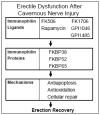Role of immunophilins in recovery of erectile function after cavernous nerve injury
- PMID: 19267858
- PMCID: PMC3361063
- DOI: 10.1111/j.1743-6109.2008.01193.x
Role of immunophilins in recovery of erectile function after cavernous nerve injury
Abstract
Introduction: Immunophilin ligands provide potentially new alternatives for the treatment of erectile dysfunction (ED), which occurs after injury of the cavernous nerves (CNs).
Aim: To review and update current knowledge of the neurotrophic effects and likely mechanism of action of immunophilin proteins with emphasis on the FK506-binding protein (FKBP) subfamily and the role of immunophilin ligands for the treatment of CN injury-induced ED.
Methods: Review of available reports of studies investigating the effects and neurotrophic mechanisms of immunophilin ligands involved in erectile function recovery in rodent models of CN injury.
Main outcome measures: Erection parameters and molecular correlations associated with CN injury and functional recovery.
Results: Treatment with prototype immunosuppressive immunophilin ligands FK506 (FK) and rapamycin (Rapa) improve erectile function in animal models of CN injury. Similarly, non-immunosuppressive analogs such as GPI-1046 and FK1706 are effective in recovery of erections after CN injury. Neuronal nitric oxide may influence the erection recovery effects of immunophilin ligands after CN injury. FKBPs 38 and 65 expression changes in the penis and its innervation coincide with the neurotrophic effects of immunophilin ligands. Antioxidative actions of immunophilin ligands contribute to their neurotrophic effects. Immunophilins are localized to nerves coursing in human prostate and penile tissue.
Conclusions: The findings support the hypothesis that immunophilin ligands, working through specific receptor mechanisms that are specific to injured CN, are potentially useful to sustain erectile function in men following radical prostatectomy.
Conflict of interest statement
Conflict of Interest: None
Figures
References
-
- Montorsi F, Burnett AL. Erectile dysfunction after radical prostatectomy. BJU Int. 2004;93:1–2. - PubMed
-
- Walsh PC, Marschke P, Ricker D, Burnett AL. Patient-reported urinary continence and sexual function after anatomic radical prostatectomy. Urology. 2000;55:58–61. - PubMed
-
- Marks AR. Cellular functions of immunophilins. Physiol Rev. 1996;76:631–649. - PubMed
-
- Snyder SH, Lai MM, Burnett PE. Immunophilins in the nervous system. Neuron. 1998;21:283–294. - PubMed
-
- Rulten SL, Kinloch RA, Tateossian H, Robinson C, Gettins L, Kay JE. The human FK506-binding proteins: characterization of human FKBP19. Mamm Genome. 2006;17:322–331. - PubMed


